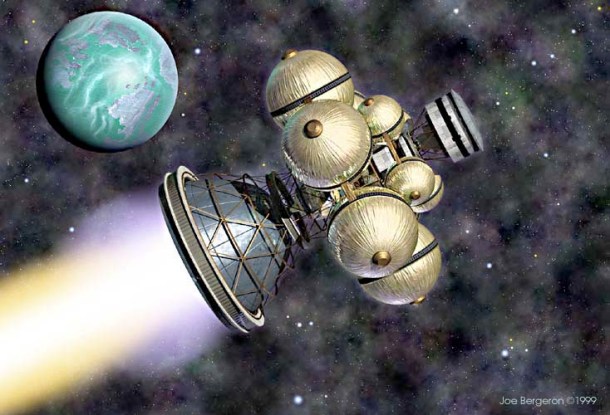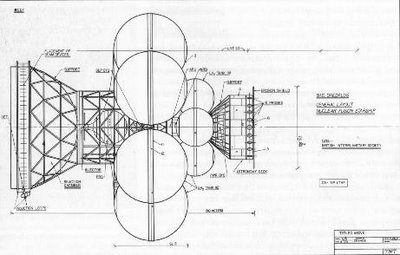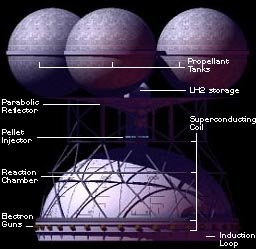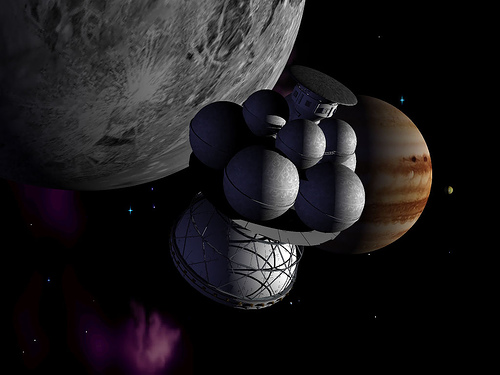
A project to send a large ship to another star still fires the imagination (at least it should). By the low standards of today, it seems an impossible dream, yet just such a ship was seriously proposed on a cold night in London in 1973. Members of the British Interplanetary Society (B.I.S.) conducted the Space Study Meeting held in London on 10 Jan. 1973 to establish the degree of interest in participating in an exploratory design study of an interstellar mission.
The idea of forming a working party composed of interested B.I.S. members was first advanced by Alan Bond in 1972. At that time interest in the field of Communications with Extraterrestrial Intelligence (CETI) was mainly focused on the problems of communication via radio signals. The point had been made that Man possessed, for the first time, the capability of detecting the existence of alien life, albeit from long range.
In parallel with this, Alan Bond argued that Man also now possessed a sufficient knowledge of science and a level of technology that a realistic attempt could be made to build an unmanned probe to reach a nearby star with existing technology, or logical extensions of it.
The public meeting in London in 1973 was during the days when the question of the time was “how do we do it?” and not “why bother at all?” As such, sufficient enthusiasm was present in the room of the Space Study Meeting and Project Daedalus was born…
Project Daedalus derived its name from the mythological Daedalus, the Greek craftsman said to have built the Labyrinth for Minos of Crete. Later falling under the displeasure of Minos, Daedalus is said to have made wings for himself and his son, Icarus, in order to escape to Sicily. Icarus disobeyed his father’s instructions and flew too close to the Sun, the heat of which melted the wax holding the wings together and Icarus fell to his death. Daedalus, on the other hand, flew neither too high nor too low, and arrived safely at his destination.
The Starship study was conducted between 1973 and 1978. Over a dozen scientists and engineers led by Alan Bond worked on the project and operated under the guidelines of the Space Study Meeting stating that:
1) The spacecraft must use current or near-future technology.
2) The spacecraft must reach its destination within a human lifetime.
3) The spacecraft must be designed to allow for a variety of target stars.
The idea of the craft being able to reach its destination within a human lifetime (a flight time of 50 years was allocated) was in order to allow the engineers who had launched the project to see it through and thus a sense of continuity would be maintained.
In order to reach even the nearest stars within the allotted fifty-year window, the scientists and engineers of the research group had a formidable task ahead of them. Their space probe would be required to accelerate to astonishing speeds, and it would need to weather the constant battering of particles from the soup of space debris known as the Interstellar Medium.
As such, the target chosen was Barnard’s Star, 5.9 light years away, which at the time was believed to possess at least one planet (the evidence on which this belief was based has since been discredited). However, the design was required to be flexible enough that it could be sent to any of a number of other target stars.
When the Society began their study, the fastest vehicle in existence was the legendary Pioneer 10, a probe which was zipping through space at a brisk 51,810 kilometers per hour. Pioneer’s journey to Jupiter was to last over a year and a half, but if it were to travel to Bernard’s Star at such a speed, it would spend approximately 123,000 years in transit. Clearly the Daedalus would require a propulsion system beyond even the best technology of the time.
Thus, after much agonizing, the team ultimately settled on proposing a fusion rocket as its drive.
Various propulsion systems had been discussed, including solar sails, fusion power and a version of the NERVA project (Nuclear Engine for Rocket Vehicle Application) which had already been abandoned by the United States. The choice, however, came down to the promising, but currently impractical interstellar ramjet, scooping up the hydrogen between the stars for fuel and nuclear pulse or internal confinement fusion. This, the option ultimately chosen, works by exploding pellets of deuterium and helium-3 in a combustion chamber like a tiny nuclear bomb. A magnetic field would stream the plasma behind the ship to propel it forward. The pellets would be ignited by high-power lasers or electron beams. A velocity of more than 104 kilometers a second could be achieved with this rocket, and so it was calculated as being able to meet the mission requirements.
Due to the scarcity of helium-3 it was to be mined from the atmosphere of Jupiter via large hot-air balloon supported robotic factories over a 20 year period.
Daedalus specifications
* Overall length: 190 meters
* Propellant mass first stage: 46,000 metric tons
* Propellant mass second stage: 4,000 metric tons
* First stage empty mass: 1,690 metric tons
* Second stage empty mass: 980 metric tons
* Engine burn time first stage: 2.05 years
* Engine burn time second stage: 1.76 years
* Thrust first stage: 7,540,000 newtons
* Thrust second stage: 663,000 newtons
* Engine exhaust velocity: 10,000,000 m/s
* Payload mass: 450 metric tons
Daedalus would be constructed in Earth orbit and have an initial mass of 54,000 metric tons (nearly 20 times the weight of the Saturn V), including 50,000 tons of fuel and 500 tons of scientific payload. Due to the extreme temperature range of operation required (from near absolute zero to 1,600 °C) the engine bells and support structure would be made of beryllium, which retains strength even at cryogenic temperatures.
Daedalus was to be a two-stage spacecraft. The first stage would operate for two years, taking the spacecraft to 7.1% of light speed (0.071 c), and then after it was jettisoned the second stage would fire for 1.8 years, bringing the spacecraft up to about 12% of light speed (0.12 c) before being shut down for a 46-year cruise period.
Using this principle, the Daedalus’s first rocket stage, would consume 46,000 tons of fuel while firing for the first two years to accelerate up to 76.6 million kilometers per hour. The Daedalus would then jettison the exhausted primary stage, shedding much of its size and weight as the second stage took over. Just shy of four years after departure, the spaceship would expend the last of its fuel, and coast for the remaining distance at the respectable speed of 135 million kilometers per hour– about 1/8 of the speed of light. By way of comparison, a vehicle traveling at that velocity could reach Jupiter from Earth in under five hours, or reach New York City from Paris in 0.156 seconds.
The second stage would have two 5-meter optical telescopes and two 20-meter radio telescopes that would be directed towards the Barnardian System twenty-five years after launch to send imagery and data back home. About two years later– approximately twenty-seven years after the probe’s departure– the first close-up photos of Barnard’s Star would finally reach the Earth. These images would reveal the exact positions of any attendant planets, allowing mission control to select points of interest. This information would be sent back to Earth, using the 40-meter diameter second stage engine bell that would also be serving as a communications dish.
Since the spacecraft would not be able to decelerate (due to the fuel that would have been required to slow the craft down) upon reaching Barnard’s Star, Daedalus would carry 18 autonomous sub-probes. Daedalus would activate these robotic passengers between 7.2 and 1.8 years before the main craft entered the target system, and assign a route based on earlier photographic findings. These eighteen sub-probes would then break away from the mothership and slip off to their destinations powered by independent ion drives. Their cameras, spectrometers, polarimeters, and other instruments would take as many pictures and readings as possible while flying past any planets at high speeds. All data would be relayed back to Earth using the powerful transmitter on the Daedalus mothership. Naturally many instruments would be tuned to search for evidence of life-harboring climates. The Daedalus and probes would have a relatively short time to make observations before zipping past the star system at over a million kilometers per hour.
Though the slow-moving particles of the Interstellar Medium are seldom larger than grains of sand, the millions of tiny, high-speed impacts would have a sandblaster effect upon the Daedalus. To combat this erosion damage, the ship’s payload bay containing its sub-probes, telescopes, and other equipment would be protected from the interstellar medium during transit by a 50-ton 7 mm-thick beryllium disk. This erosion shield would be made from beryllium due to its lightness and high latent heat of vaporization. In addition, the Daedalus would be escorted by its own artificially generated particle cloud, which would precede the spaceship at the same extreme speed, sweeping most larger objects out of the path.
The spacecraft would also carry a number of robot “wardens” networked to the Daedalus master computer and would be capable of autonomously repairing damage or malfunctions.
Variant
A quantitative engineering analysis of a self-replicating variation on Project Daedalus was published in 1980 by Robert Freitas. The non-replicating design was modified to include all subsystems necessary for self-replication, using the probe to deliver a “seed” factory with a mass of about 443 metric tonnes to a distant site, having the seed factory replicate many copies of itself there to increase its total manufacturing capacity, and then using the resulting automated industrial complex to construct more probes with a single seed factory on board each over a 1,000 year period. Each REPRO would mass over 10 million tons, mostly fuel needed to decelerate from 12% of lightspeed.
******
Well, none of this has happened, of course, and several decades later we’re no closer to building such a craft. New techniques and technologies have detected a plethora of planets orbiting nearby stars.
Technologies are here today which could bring Daedalus– or something like it– to fruition. But at some point, our culture of choosing challenge over comfort, innovation over emulation and transformation over torpor was smothered by a culture of “why bother” and great scientists were pressured to shelve their “absurd” ambitions for more “practical” pursuits.
Why did we as a society allow this to happen? We are capable of breaking through the limits imposed by our natural heritage – of applying the evolutionary gift of our rational, empirical intelligence to strive to surpass the confines of our human limits.
Will we reject blind faith and the passive, comfortable thinking that leads to dogma, conformity, and stagnation by turning to what should be our destiny in the stars? Or will we continue our decline – preferring fuzzy but comfortable delusion to analytical thoughts, mysticism to empiricism and conformity for independent evaluation?
Great societies do not accept revelation, authority, or emotion as reliable sources of knowledge. Rational societies recognize that advancing individually and socially calls for critically challenging the dogmas and assumptions of the past while resisting the popular delusions of the present
I say we have tolerated this present, pernicious culture of impotence, fear and ignorance long enough. How long must we stand by and watch brave proposals collect dust? It is time for us to be bold and to seize greatness. It is time for a massive interstellar space probe.
If we are content to live in the past, we have no future. And today is the past.





Hey,
I read this article awhile back. It was late one night and I was interested in seeing if anyone had ever planned any space missions like Daedalus. So, I came across this article. I am excited to know such a mission was planned, and indeed is possible. I share your disappointment that humanity hasn’t gotten of its collective ass and made Daedalus happen. Anyway, I just wanted you to know I share your views brother, feel free to send me an email.
later,
-T.C.
I too am heartbroken at the worsening slowness in our progress that followed the Apollo era. I am designing a Daedalus-like variant of Project Orion dubbed “Project Orion II” to send missions to the stars. I am very disappointed in humanity and some rocket scientists say we will never reach the stars, shame on them. Just not with ion or chemical rockets, etc. But the very Daedalus that two of those pessamistic articles show proves them wrong. I too share your views.
“I say that we have tolerated this present, pernicious culture of impotence, weakness and ignorance long enough. How long must we stand by and watch brave proposals collect dust? It is time for us to seize greatness. It is time for a massive interstellar space probe.”
I totally agree to the nth degree, I am sick of this slowness and I thak you very much Velvet Rocket, you are the best! I will link you to by blog Ad Astra Orionis! Shame on Wired and Universe Today for their pessimissim saying that we will never reach the stars, it is just not with todays chemical rockets, ion craft, or fission nuclear rockets etc. But Daedalus and Orion II will change all of that! I heard a nay sayer’s straw men saying starflight proponents are Ufologists or just wishful thinkers. I straw man is a logical fallacy that distorts and later claims to defeat an opponent’s argument. I am NOT a Ufologist and I advocate Starflight and the large interstellar probe!
Pingback: Nikola Tesla’s Wardenclyffe Tower and Laboratory « The Velvet Rocket
I am protective of an erotic Star Wars eel known as a Colo Claw Fish. I take Colo Claw Fish under my wing in interstellar voyages of the mind. The underlying reason why I am so positive towards Colo Claw Fish is that I totally agree with you in that we must stop playing around in this pernicious society of impotence and obsessive militarism and work together internationally and develop an interstellar probe such as Project Orion II. Let Colo Claw Fish and I quote this marvelous line that I love:
“I say that we have tolerated this present, pernicious culture of impotence, fear and ignorance long enough. How long must we stand by and watch brave proposals collect dust? It is time for us to be bold and to seize greatness. It is time for a massive interstellar space probe.”
I have been designing Project Orion II ever since I first came up with that interstellar brainchild in the morning of Thursday, February 18, 1999. My positive feelings towards Colo Claw Fish shall be a science fiction means to inspire others to get out of this current culture of impotence, fear, militarism, and ignorance and to start working together and developing Project Orion II.